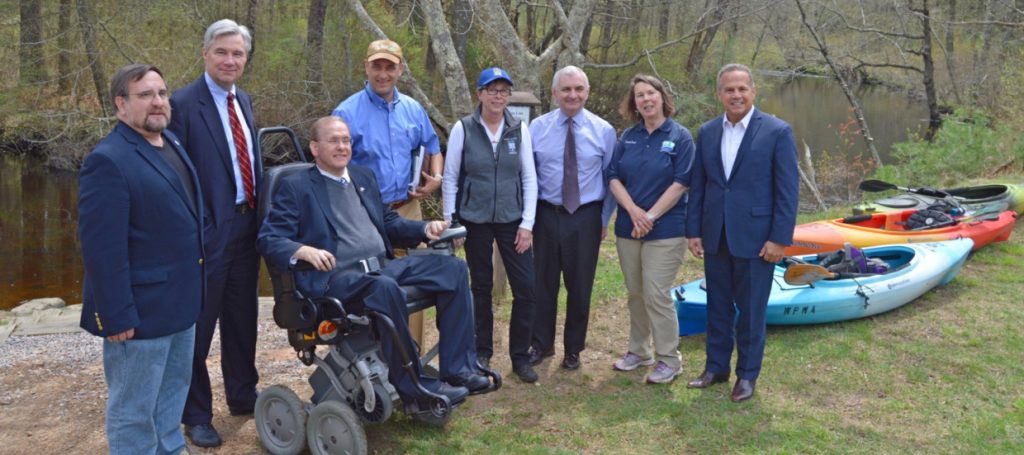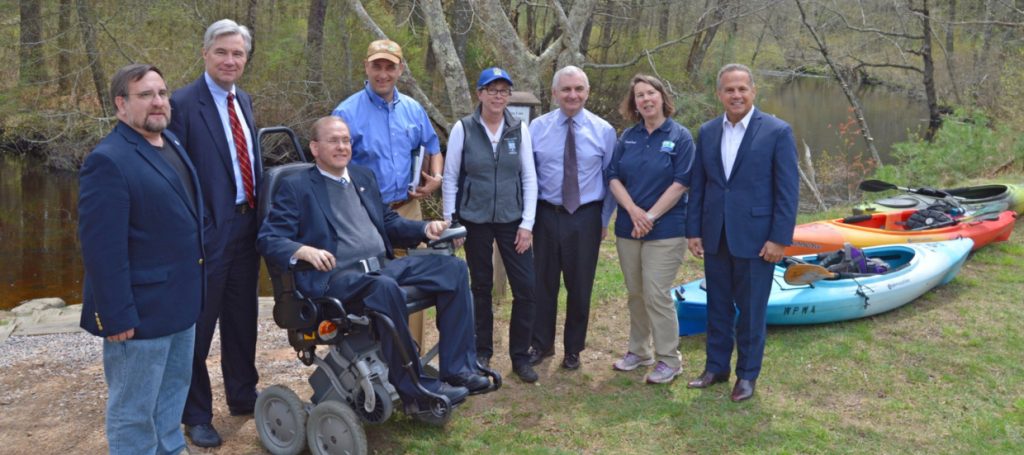RI & CT Partners to Celebrate Wild and Scenic Rivers


After Reed-Langevin Wood-Pawcatuck Watershed Wild and Scenic River Act signed into law last month as part of public lands package, conservation, community, and volunteer groups come together to celebrate ‘Wild and Scenic’ designation for segments of the Wood-Pawcatuck Watershed and protections and opportunities that come with it
Federal designation could help federal funds flow for water quality, recreational access, flood resiliency, and habitat protection initiatives
EXETER, RI – On Monday, April 8 at 10:30 a.m., U.S. Senator Jack Reed (D-RI), U.S. Senator Sheldon Whitehouse (D-RI), Congressman Jim Langevin (D-RI), and Congressman Joe Courtney (D-CT) will join state officials, the Wood-Pawcatuck Watershed Association (WPWA), and local conservation partners along the Wood River to celebrate passage of a new law designating key segments of the Wood-Pawcatuck watershed as part of the National Wild and Scenic Rivers System.
Last month, President Trump signed into law a bipartisan public lands package to protect more than 1.3 million acres of new wilderness area, 2,600 miles of new national trails, and 367 miles of new scenic rivers, including language from Senator Reed’s Wood-Pawcatuck Watershed Wild and Scenic Rivers Act. The law establishes Rhode Island’s first ever Wild and Scenic river system and will provide access to federal funding to protect and maintain the rivers of this watershed for recreation, fisheries, and water quality preservation.
A river’s classification as “wild” means there is little development in surrounding areas and “scenic” means it is still largely undeveloped, but accessible in places by roads.
Designating these segments of the 300-square mile Wood-Pawcatuck Watershed under the Wild and Scenic Rivers Act (WSRA) will open the door to additional federal preservation funding and support from the National Park Service. However, a Wild and Scenic designation does not give the federal government control of the property or prohibit future development.
The designation includes parts of seven rivers: the Beaver, Chipuxet, Green Fall-Ashaway, Queen-Usquepaugh, Pawcatuck, Shunock, and Wood rivers in Rhode Island and Connecticut, under WSRA protections, further preserving Southern New England’s natural beauty. It also formally recognizes the recreational, natural, and historical qualities of these river segments, provides access to federal resources, and promotes strong partnerships for their restoration and protection.
The establishment of the Wood-Pawcatuck watershed as part of the National Wild and Scenic Rivers System was the result of a grassroots public effort over many years. The effort was sparked by concerned citizens and conservation organizations in Rhode Island and Connecticut who worked collaboratively and enlisted the help of their Congressional delegations.
The Wood-Pawcatuck Watershed Association (WPWA) and its partners began working to get national ‘wild and scenic’ recognition for the watershed in 2010. In 2010, Congressman Langevin introduced the Wood-Pawcatuck Watershed Protection Act to study these rivers for inclusion in the National Wild Scenic River System. Senator Reed successfully included study language in the 2014 National Defense Authorization Act (NDAA).
WPWA led the three-year study and worked with local stakeholders on a comprehensive Wood-Pawcatuck Wild and Scenic Rivers Stewardship Plan. This Stewardship Plan outlines special values of each river, projects to enhance and protect these rivers, and the role of the Stewardship Council. Special values of the watershed and river segments fell into several categories, most notably outstanding ecosystems and recreational paddling and fishing.
The Stewardship Plan was developed in consultation with town-appointed representatives from Charlestown, Exeter, Hopkinton, North Kingstown, Richmond, South Kingstown, Westerly, and West Greenwich in Rhode Island and North Stonington, Sterling, Stonington, and Voluntown in Connecticut. The bi-state study committee also included partners from the Rhode Island Department of Environmental Management (RIDEM), the Connecticut Department of Energy and Environmental Protection (CT DEEP), the Narragansett Indian Tribe, the Wood Pawcatuck Watershed Association (WPWA), Save the Bay, The Nature Conservancy, and the Audubon Society of Rhode Island. Technical assistance for the study was provided by the National Park Service.
Now that Wild and Scenic designation is in place, the Stewardship Plan will be implemented by the Wood-Pawcatuck Stewardship Council. This group will regularly hold watershed wide conversations to discuss issues, create and implement solutions. Representation on this Council will be similar to the previous Study Committee, including watershed towns, state environmental agencies and several key non-profits. This May, the Stewardship Council will meet for the first time.
To date, over 200 rivers in 40 states across the country have been accepted into the National Wild Scenic River System, but until now, none in Rhode Island had received the designation.

